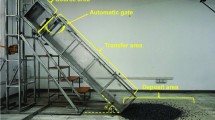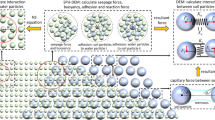Abstract
On 28 July 2013, an intense torrential rainfall occurred at the boundary of Yamaguchi and Shimane Prefectures in western Japan, and triggered a debris flow on an ungauged hillslope to bury the entrance of Shirai tunnel and to shutdown railway service in that region for 1 year. To assess this disaster, this study aims at numerically modeling this debris flow event through a methodology incorporating empirical hydrologic analysis and mechanical debris flow model. For hydrologic analysis, the SCS-CN method implemented by HEC-HMS was used to obtain direct runoff hydrograph with high-resolution precipitation data reanalyzed using observations from radars and rain gauges. Then, the obtained runoff-discharge information was applied as an input for numerically simulating the debris flow movement from source to deposition areas. The simulation result is verified by the field evidence from field survey. The study demonstrates the applicability of the proposed empirical–mechanical approach for assessing debris flows in ungauged basins.











Similar content being viewed by others
References
Bezak N, Auflič MJ, Mikoš M (2019) Application of hydrological modelling for temporal prediction of rainfall-induced shallow landslides. Landslides 16(7):1273–1283
Bollermann A, Chen G, Kurganov A, Noelle S (2013) A well-balanced reconstruction of wet/dry fronts for the shallow water equations. J Sci Comput 56(2):267–290
Capra L, Coviello V, Borselli L, Márquez-Ramírez VH, Arámbula-Mendoza R (2018) Hydrological control of large hurricane-induced lahars: evidence from rainfall-runoff modeling, seismic and video monitoring. Nat Hazard Earth Sys 18(3)
Cascini L, Cuomo S, Pastor M, Sorbino G, Piciullo L (2014) Sph run-out modelling of channelised landslides of the flow type. Geomorphology 214:502–513
Chae BG, Park HJ, Catani F, Simoni A, Berti M (2017) Landslide prediction, monitoring and early warning: a concise review of state-of-the-art. Geosci J 21(6):1033–1070
Chae BG, Wu YH, Liu KF, Choi J, Park HJ (2020) Simulation of debris-flow runout near a construction site in Korea. Appl Sci 10(17):6079
Chen YC, Wu YH, Shen CW, Chiu YJ (2018) Dynamic modeling of sediment budget in shihmen reservoir watershed in Taiwan. Water 10(12):1808
Choi J (2018) Investigation of the 2013 Hadari debris flow in Korea through field survey and numerical analysis. KSEG J Eng Geol 28(3):341–348
Choi J, Chae B, Liu K, Wu Y (2016) Numerical analysis of debris flow hazards from case study. In: Landslides and engineered slopes. Experience, theory and practice. CRC Press, pp 649–656
Chow VT, Maidment DR, Mays LW (1988) Applied hydrology. McGraw-Hill, New York
Cronshey RG, Roberts RT, Miller N (1985) Urban hydrology for small watersheds (TR-55 Rev.). In: Hydraulics and hydrology in the small computer age, ASCE, pp 1268–1273
Fang K, Liu Z, Zou Z (2015) Efficient computation of coastal waves using a depth-integrated, non-hydrostatic model. Coast Eng 97:21–36
Gottlieb S, Shu CW, Tadmor E (2001) Strong stability-preserving high-order time discretization methods. SIAM Rev 43(1):89–112
Gregoretti C, Degetto M, Boreggio M (2016) Gis-based cell model for simulating debris flow runout on a fan. J Hydrol 534:326–340
Grimaldi S, Petroselli A (2015) Do we still need the rational formula? An alternative empirical procedure for peak discharge estimation in small and ungauged basins. Hydrol Sci J 60(1):67–77
Grimaldi S, Petroselli A, Nardi F (2012) A parsimonious geomorphological unit hydrograph for rainfall-runoff modelling in small ungauged basins. Hydrol Sci J 57(1):73–83
Grimaldi S, Petroselli A, Romano N (2013) Green-ampt curve-number mixed procedure as an empirical tool for rainfall-runoff modelling in small and ungauged basins. Hydrol Process 27(8):1253–1264
Hibino K, Takayabu I, Wakazuki Y, Ogata T (2018) Physical responses of convective heavy rainfall to future warming condition: Case study of the hiroshima event. Front Earth Sci 6:35
Horváth Z, Waser J, Perdigão RA, Konev A, Blöschl G (2015) A two-dimensional numerical scheme of dry/wet fronts for the Saint-Venant system of shallow water equations. Int J Numer Meth Fluids 77(3):159–182
Hsu YC, Liu KF (2019) Combining TRIGRS and DEBRIS-2D models for the simulation of a rainfall infiltration induced shallow landslide and subsequent debris flow. Water 11(5):890
Hürlimann M, Coviello V, Bel C, Guo X, Berti M, Graf C, Hübl J, Miyata S, Smith JB, Yin HY (2019) Debris-flow monitoring and warning: review and examples. Earth-Sci Rev 102981
Iseri H, Hiramatsu K, Harada M, Mori M et al (2013) Simulation of rainfall runoff and pollutant load for chikugo river basin in japan using a gis-based distributed parameter model. Paddy Water Environ 11(1–4):97–112
Iverson RM, George DL (2014) A depth-averaged debris-flow model that includes the effects of evolving dilatancy. I. Physical basis. Proc R Soc A-Math Phys 470(2170):20130819
Jeong SW (2013) Determining the viscosity and yield surface of marine sediments using modified Bingham models. Geosci J 17(3):241–247
Jeong S, Wu YH, Cho Y, Ji S (2018a) Flow behavior and mobility of contaminated waste rock materials in the abandoned Imgi mine in Korea. Geomorphology 301:79–91
Jeong SW, Park SS, Fukuoka H (2018b) Shear and viscous characteristics of gravels in ring shear tests. Geosci J 22(1):11–17
JMA (2020) Database of past weather data. http://www.jam.go.jp/. Accessed 10 Mar 2020
Kim MI, Kwak JH, Kim BS (2018) Assessment of dynamic impact force of debris flow in mountain torrent based on characteristics of debris flow. Environ Earth Sci 77(14):538
Kurganov A, Miller J (2014) Central-upwind scheme for Savage-Hutter type model of submarine landslides and generated tsunami waves. Comput Methods Appl Math 14(2):177–201
Kurganov A, Petrova G (2007) A second-order well-balanced positivity preserving central-upwind scheme for the Saint-Venant system. Commun Math Sci 5(1):133–160
Lambe TW, Whitman RV (1979) Soil mechanics, SI version. Wiley, New York
Liu KF, Wei SC, Wu YH (2014) The influence of accumulated precipitation on debris flow hazard area. In: Landslide science for a safer geoenvironment. Springer, New York, pp 45–50
Liu KF, Huang MC (2006) Numerical simulation of debris flow with application on hazard area mapping. Computat Geosci 10(2):221–240
Liu KF, Wu YH (2018) Txt-tool 3.886-1.1: Debris2d tutorial. In: Sassa K, Tiwari B, Liu KF, McSaveney M, Strom A, Setiawan H (eds) Landslide dynamics: ISDR-ICL landslide interactive teaching tools : volume 2: testing, risk management and country practices. Springer, New York, pp 181–189
Liu KF, Wu YH, Chen YC, Chiu YJ, Shih SS (2013) Large-scale simulation of watershed mass transport: a case study of Tsengwen reservoir watershed, southwest Taiwan. Nat Hazards 67(2):855–867
Lora M, Camporese M, Troch PA, Salandin P (2016) Rainfall-triggered shallow landslides: infiltration dynamics in a physical hillslope model. Hydrol Process 30(18):3239–3251
Melo R, van Asch T, Zêzere J (2018) Debris flow run-out simulation and analysis using a dynamic model. Nat Hazard Earth Syst 18(2):555–570
Miyabuchi Y, Maeno F, Nakada S (2015) The october 16, 2013 rainfall-induced landslides and associated lahars at Izu Oshima volcano, Japan. J Volcanol Geotherm Res 302:242–256
Nayak S, Takemi T (2020) Typhoon-induced precipitation characterization over northern Japan: a case study for typhoons in 2016. Prog Earth Planet Sci 7(1):1–12
NRCS (2009) Part 630 hydrology national engineering handbook. Natural Resources Conversation Services (NRCS), United States Department of Agriculture (USDA), Washington, DC
Pradhan AMS, Kang HS, Lee S, Kim YT (2017) Spatial model integration for shallow landslide susceptibility and its runout using a gis-based approach in yongin, korea. Geocarto International 32(4):420–441
Rigon R, Bancheri M, Formetta G, de Lavenne A (2016) The geomorphological unit hydrograph from a historical-critical perspective. Earth Surf Proc Land 41(1):27–37
Scharffenberg WA (2013) Hydrologic modeling system HEC-HMS: user’s manual, version 4.0. US Army Corps of Engineers, Hydrologic Engineering Center
Segoni S, Piciullo L, Gariano SL (2018) A review of the recent literature on rainfall thresholds for landslide occurrence. Landslides 15(8):1483–1501
Shakti PC, Nakatani T, Misumi R (2017) Hydrological simulation of small river basins in northern Kyushu, Japan, during the extreme rainfall event of July 5–6. J Disaster Res 13(2):396–409
Shehata M, Mizunaga H (2018) Flash flood risk assessment for Kyushu island, Japan. Environ Earth Sci 77(3):76
Stancanelli LM, Peres DJ, Cancelliere A, Foti E (2017) A combined triggering-propagation modeling approach for the assessment of rainfall induced debris flow susceptibility. J Hydrol 550:130–143
Tai YC, Heß J, Wang Y (2019) Modeling two-phase debris flows with grain-fluid separation over rugged topography: application to the 2009 Hsiaolin event, Taiwan. J Geophys Res Earth Surf 124(2):305–333
Takahashi T (2014) Debris flow: mechanics, prediction and countermeasures. CRC Press, New York
Tsuguti H, Seino N, Kawase H, Imada Y, Nakaegawa T, Takayabu I (2019) Meteorological overview and mesoscale characteristics of the heavy rain event of July 2018 in Japan. Landslides 16(2):363–371
Verma S, Mishra S, Singh A, Singh P, Verma R (2017) An enhanced sma based scs-cn inspired model for watershed runoff prediction. Environ Earth Sci 76(21):736
Wang F, Kuwada Y, Shimitsu R, Tasaka I, Araiba K, Endo M (2014) Landslides triggered by a heavy rainfall at the boundary of Yamaguchi and Shimane prefectures in July 2013. J Jpn Landslide Soc 51(2):66–69
Wang F, Wu YH, Yang H, Tanida Y, Kamei A (2015) Preliminary investigation of the 20 August 2014 debris flows triggered by a severe rainstorm in Hiroshima city, Japan. Geoenviron Disasters 2(1):17
Wei SC, Li HC, Shih HJ, Liu KF (2018) Potential impact of climate change and extreme events on slope land hazard-a case study of Xindian watershed in Taiwan. Nat Hazard Earth Syst 18(12):3283–3296
Whiteley J, Chambers J, Uhlemann S, Wilkinson P, Kendall J (2019) Geophysical monitoring of moisture-induced landslides: a review. Rev Geophys 57(1):106–145
Wu YH, Liu KF (2014) The influence of countermeasure on debris flow hazards with numerical simulation. In: Landslide science for a safer geoenvironment. Springer, New York, pp 473–478
Wu YH, Liu KF (2015a) Formulas for calibration of rheological parameters of Bingham fluid in Couette rheometer. J Fluid Eng-T ASME 137(4):041202
Wu YH, Liu KF (2015b) Start-up flow of a Bingham fluid between two coaxial cylinders under a constant wall shear stress. J Non-Newton Fluid Mech 223:116–121
Wu YH, Nakakita E (2019) Assessment of landslide hazards using logistic regression with high-resolution radar rainfall observation and geological factor. J Jpn Soc Civil Eng Ser B1 (Hydraulic Eng) 75(2):157–162
Wu YH, Liu KF, Chen YC (2013) Comparison between FLO-2D and Debris-2D on the application of assessment of granular debris flow hazards with case study. J Mt Sci 10(2):293–304
Zhang P, Ma J, Shu H, Han T, Zhang Y (2015) Simulating debris flow deposition using a two-dimensional finite model and soil conservation service-curve number approach for Hanlin gully of southern Gansu (China). Environ Earth Sci 73(10):6417–6426
Acknowledgements
This work was initiated when Y.H.W. stayed in Shimane University in Japan with the financial support. Y.H.W. appreciates the photos and the relating data from Prof. F. Wang, R. Shimitsu, and Y. Tanida. GIS data and aerial photos were accessed from Geospatial Information Authority of Japan. Geological information was accessed from Geological Survey of Japan. The Radar/Rain gauge analyzed (Radar-AMeDAS) precipitation data are obtained from Japan Meteorological Business Support Center. The JMA Radar synthetic precipitation data were collected and distributed by Research Institute for Sustainable Humanosphere, Kyoto University.
Author information
Authors and Affiliations
Corresponding author
Additional information
Publisher's Note
Springer Nature remains neutral with regard to jurisdictional claims in published maps and institutional affiliations.
Rights and permissions
About this article
Cite this article
Wu, YH. Coupled empirical–mechanical modeling of debris flows occurred in small ungauged basins. Environ Earth Sci 80, 45 (2021). https://doi.org/10.1007/s12665-020-09318-3
Received:
Accepted:
Published:
DOI: https://doi.org/10.1007/s12665-020-09318-3




